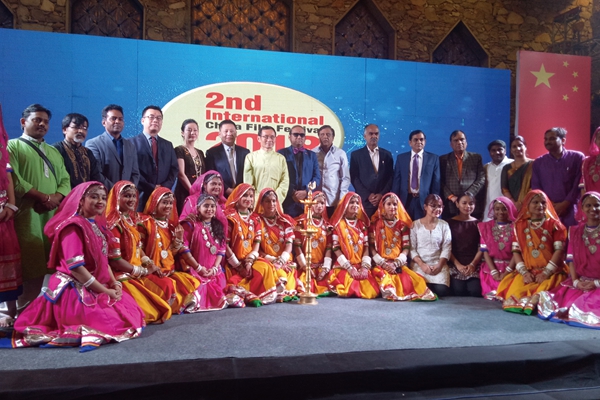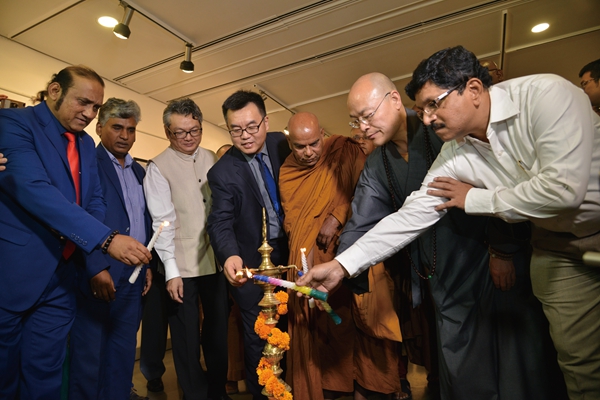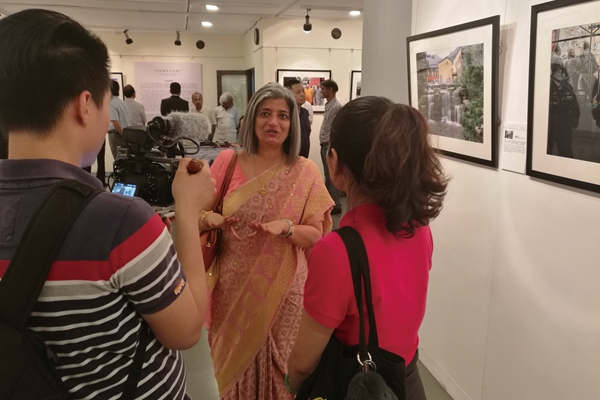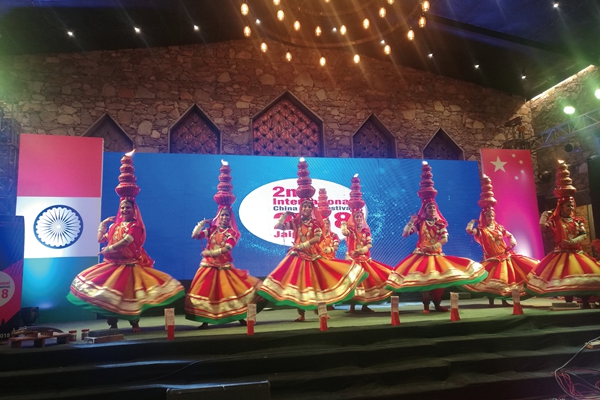Art Lightens Heart, Culture Passes Friendship
A closer look at India, "Photo Exhibition of Chinese Buddhist Cultural Heritage" and "Chinese Film Exhibition"

CFLAC delegation takes group photo with celebrities from India's movie industry

China and India guests jointly conduct lighting for the ceremony LI Xiaoyuan/Photo

The photo exhibition attracts high-level sorghum, samurai and local people from the Buddhist circles of China and India. MIAO Hong/Photo

Indian song and dance for the screening event
If you go to India and ask a local resident casually if they could talk about the feelings of Buddhism and movies, they will naturally "shaking head" to affirm, even talk for a long time with pride and interests.India is a mysterious country full of religious colors. The Indian people's worship of religion and their passion for movies seem to be born with lives.
In order to promote exchanges and cooperation between China and India in cultural and artistic exchanges and enhance mutual understanding between the two peoples, "China Today " Art Week-"Photo Exhibition of Chinese Buddhist Cultural Heritage" and "Chinese Film Exhibition" events have been held in Mumbai and Jaipur of India respectively from 16-20 March under joint organization of China Federation of Literary and Art Circles, the Buddhist Association of China and Mumbai National Performing Arts Center. The events were undertaken by China Photographers Association, China Film Association, Indian Musicians Federation, Maharashtra State Art Institute and IndiaChina Film Society based upon the signing of the Memorandum of Cooperation between CFLAC and Indian Council of Cultural Relationship.
Connecting hearts of Buddha, mutual trust & love, more colorful civilization due to exchanges
The holy land of the Buddha, India, is extremely hot and the temperature is as high as 38 degrees in March. The National Performing Arts Center in Mumbai is a local state-level cultural and arts exhibition venue in India. It is indeed particularly unique as it can hold Buddhist cultural heritage photo exhibitions.
On March 16th, the staff of the China Photographers Association had already displayed a new decoration of the picture layout in the exhibition hall of the museum art center, with each piece of work set with instructions in both Chinese and English.
As a populous country, India does not lack audience. Local politicians, Buddhists and people from all walks of life have come before the ceremony officially started as the scene was crowded with so many people.LI Haixing, a staff member of the Buddhist Association of China, said: "We will have unique Buddhist cultural heritage and achievements of the Buddhist cause in China presented to Indian audiences, including Lingyin Temple, Jokhang Temple, statue of Sleeping Buddha, Yungang Grottoes of Datong, Shanxi, Samantabhadra of Emei Mount, Ningma-school murals and others to expand and enhance the cultural exchanges between China and Indiaand boost the two ancient civilizations to learn from each other through friendship and mutual understanding."From the look of Indian audiences admiring the pictures, it looked as if the viewer was engaged in spiritual communication with the work and has appreciated the artistic conception expressed in the picture. It also seems that there was not much obstacle in conversations in the exhibition.SHI Guangquan, the deputy secretary-general of the Buddhist Association of China and the abbot of the Lingyin Temple in Hangzhou, said at the ceremony: "In the more than two thousand years of friendly exchanges between China and India, Buddhism has played an important role. The 80 pictures displayed in the exhibition concerning more than a dozen aspects, such as sculptures, architecture, relics, festivals, celebrations, education and classics were selected from nearly 20,000 pieces of Buddhist cultural heritage photographs. The audiencescould intuitively experience the historical development and changes of Buddhist culture in China, displaying the historical and cultural treasures and contemporary development of China’s Buddhism in all directions."
"In order to promote mutual understanding between the two countries' cultures and advance thebilateral cultural exchange and cooperation, CFLAC and related parties from Indian culture and arts circle have proactively organized exchanges and visits in terms of music, dance, film, photography and others. The two sides have worked closely and partnered together to express the long history and culture of the two countries through arts, conveying the profound friendship between the two peoples."said MIAO Hong, head of the CFLAC delegation.
Sharing the achievements of human civilization and showcasing the charm of Chinese culture have become the highlights of this event.The Chinese Consul General in Mumbai, ZHENG Xiyuan said: "Buddhism has had a profound impact on Chinese people’s religious beliefs, philosophy, literature and arts, etiquette and customs. And the Chinese have developed Buddhist ideas based on our culture and formed unique Buddhist theories. The magnificent Buddhist traditional culture can be said to be the largest common divisor in Chinese-Indian relations."
The Buddhist community in Mumbai has showed great enthusiasm and interest for this activity and proactively evaluated the endeavors made by the two countries to further promote Buddhist cultural exchanges.The nearly one-week long exhibition has attracted more than a thousand visitors. It will also visit India’s other relevant states and cities to organize roving exhibitions at the invitation from Indian side. And all the pictures will be collected by the Indian Institute of after the exhibition ends. The people in the Buddhist circles of China and India have won a great success together, showing that the peoples of the two countries share a close feeling in the inheritance of the spirit of charity and benevolence. This activity will surely make positive contributions to consolidate and develop the traditional friendship between China and India.
Art exchange conveying complements, civilization becomes richer via learning
Movies are said to be most popular in India, showing considerable box office revenue. The recent years have witnessed an increasing number of film and television exchanges between China and India, including the Dangal, Secret Superstar,BajrangiBhaijaan and other inspirational and humanistic Indian films have been refreshing,leaving a deep impression on the Chinese audiences.China and India share experience in film exchanges and cooperation. As an important section of the China Today Art Week, the Chinese Film Association has brought five domestic movies, including Monster Hunt, Wolf Totem, The Grandmaster, Go away Mr. tumour and Xuan Zang, holding a week-long event at the cinemas of Jaipur of Rajasthan in India. The Indian people love movies, aswatching movies has become an important part of their life. Under normal circumstances, it is not a problem for Indians to spend a few hours in the cinema, and they will dance with the rhythm of the movie music every time they find the dynamics. The exhibition was higjhly supported by the government of Rajasthan and the Chinese Film Society of India, designating the film screening event held in Jaipur, the capital of India's ancient tourist city Rajasthan.
At the opening ceremony, the author saw the beautifully printed promotional advertisements made by the Indian side, who greeted the Chinese delegation in Rajasthani’s way. The Indian traditional etiquette called "Lighting", an indispensable blessing ceremony was held before the event. After hearing the news about the event, the Chinese Embassy in New Delhi has designated officials to take 4-hour drive to Jaipur in particular.
ZHANG Jianxin, Cultural Counselor of the Chinese Embassy in India, said emotionally: "For years of working and living in India, we seldom see Indian side organizing such large-scale and highquality film events for China, stating that the choice of film arts as the link between the people of China and India is of positive significance." The well-known Indian directors, producers and Bollywood singers who attended the event gathered here have enhanced friendship in the interactive exchange of performances, share the achievements of development of Chinese and Indian films and experience the charm of Chinese movies.Nitin Sharma, director of international film, said: "Chinese films are developing rapidly. Chinese and Indian audiences share common preferences about film, as the Chinese kung fu and comedy movies are most popular with Indian audiences." PradeepBorar, Tourism Director of Rajasthan said at the ceremony: "The Chinese movie market has great potential. Chinese audiences like Indian movies as well. Similarly, there are also markets as the Chinese films come to India for exhibitions. I hope that the two countries will step up cooperation in film exchanges."SUN Chonglei, deputy secretarygeneral of the China Film Association, stated: "In recent years, China-India movie culture exchanges have achieved positive progress. The two nations have formed extensive consensus on the prosperity of the film industry and the promotion of diversification of the world's movies. The two countries' film industry has activelycreated a good condition for strengthening cooperation, learning from each other and expanding exchanges. As Indian movies enter into China, it is also expected that more and more Chinese films will debut in front of Indian audiences."
Recognition of harmony, understanding &tolerance, civilization everlasting via integration
JI Xianlin once said: "In the history of the world, cultural exchange between China and India must be the one if we should give an example of cultural exchanges that make both sides profitable." The Indian poet Tagore even called China and India "old and dear brothers".China and India, both the world's most populous and neighboring countries of great significance, have a long history of culture and pertinent exchanges. The cultures of the two nations share a similar oriental multiculturalism, featuring mutual reference and complementarity in deepening cultural exchanges. And both sides always maintain the spirit of "mutual trust, peace, and friendship". This series of activities is in line with the concept of friendly development. During the interim of the photo exhibition activities, the Indian side especially arranged Chinese Buddhists to visit the father of the Indian constitution, the former residence of leader of the new Buddhist movement Ambedkar, hold a symposium with the Indian mastersat temple of Chaitya Bhoomi and pay a special visit to the University of Somaiya and the Buddhist Research Center. Indian youth students were as passionate as the "idolaters of superstars" in meeting the Chinese monks, and the cultural recognition stemmed from the heart.
Xinhua News Agency and a number of local Indian media made the following comments: "Buddhism is a world-class religion that displays and describes the diversity of glorious human civilization. China and India are committed to improving cultural exchange through music, tea ceremony, martial arts, calligraphy and painting. Observing the east through the exhibition, this Buddhist art exhibition provides a new perspective for the audiences to complete a visual pilgrimage."
"The multi-angle display of the development of Chinese Buddhist civilization is really an unexpected surprise for us, which also generates more of a yearning for China." said an Indian audience. Kishore Jawade, chief executive of the Indian film, said: "The rich subjects and variety of styles concerning the filmsbrought by China help deepen the understanding and acknowledgement of Chinese history and culture of the Indian audiences. Chinese and Indian films could learn from each other,tell greatstories, make progress together and seek development and mutual benefit."














